
A suitcase is a form of baggage. It is a rectangular container with a handle and is typically used to carry one's clothes and other belongings while traveling. The first suitcases appeared in the late 19th century due to the increased popularity of mass tourism at the time and were meant to hold dress suits. They were originally made using heavier materials such as leather or steel, but, beginning in the 1930s, were constructed with more lightweight materials like plastic and cardboard.

A pannier is a basket, bag, box, or similar container, carried in pairs either slung over the back of a beast of burden, or attached to the sides of a bicycle or motorcycle. The term derives from a Middle English borrowing of the Old French panier, meaning 'bread basket'.

Lost luggage is luggage conveyed by a public carrier such as an airline, seafaring cruise ship, shipping company, or railway which fails to arrive at the correct destination with the passenger. In the United States, an average of 1 in 150 people have their checked baggage misdirected or left behind each year.
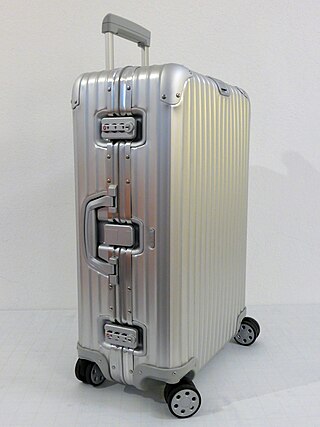
Baggage or luggage consists of bags, cases, and containers which hold a traveler's personal articles while the traveler is in transit. A modern traveler can be expected to have packages containing clothing, toiletries, small possessions, trip necessities. On the return trip, travelers may have souvenirs and gifts. For some people, luggage and the style thereof is representative of the owner's wealth and status. Luggage is constructed to protect the items during travel either with a hard shell or a durable soft material. Luggage often has internal subdivisions or sections to aid in securing items. Handles are typically provided to facilitate carrying, and some luggage may have wheels and/or telescoping handles or leashes to make moving them easier.

A handbag, commonly known as a purse in North American English, is a handled medium-to-large bag used to carry personal items. It has also been called a pocketbook in parts of the U.S.
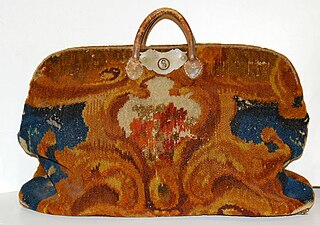
A carpet bag is a top-opening travelling bag made of carpet, commonly from an oriental rug. It was a popular form of luggage in the United States and Europe in the 19th century, featuring simple handles and only an upper frame, which served as its closure. Some small modern versions are used as handbags or purses.
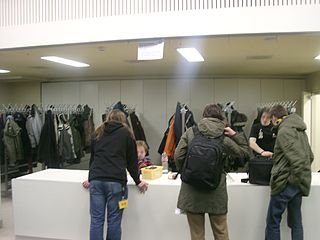
A cloakroom, known as a coatroom and checkroom in North America, is a room for people to hang their coats, cloaks, canes, umbrellas, hats, or other outerwear when they enter a building. Cloakrooms are typically found inside large buildings, such as gymnasiums, schools, churches or meeting halls.

The term hand luggage or cabin baggage refers to the type of luggage that passengers are allowed to carry along in the passenger compartment of a vehicle instead of a separate cargo compartment. Passengers are allowed to carry a limited number of smaller bags with them in the vehicle, which typically contain valuables and items needed during the journey. There is normally storage space provided for hand luggage, either under seating, or in overhead lockers. Trains usually have luggage racks above the seats and may also have luggage space between the backs of seats facing opposite directions, or in extra luggage racks, for example, at the ends of the carriage near the doors.
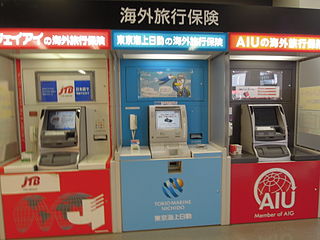
Travel insurance is an insurance product for covering unexpected losses incurred while travelling, either internationally or domestically. Basic policies generally only cover emergency medical expenses while overseas, while comprehensive policies typically include coverage for trip cancellation, lost luggage, flight delays, public liability, and other expenses.
In charitable organizations, a drive is a collection of items for people who need them, such as clothing, used items, books, canned food, cars, etc. Some drives ask that people go through their inventory, bag the items up, and put them in a giveaway bin, or charitable organizations such as Big Brothers Big Sisters, The Salvation Army come to the house and pick them up. They then put the items in their thrift stores or, if they don't have any, sell them to thrift stores to raise money for their organization.
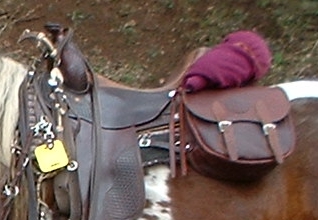
Saddlebags are bags that are attached to saddles.
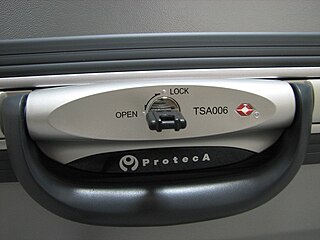
A luggage lock is a lock used to prevent luggage from opening by accident, usually with little or no security in mind, although the lock may serve as a deterrent to potential thieves. Luggage locks may be built into luggage or may be external locks such as padlocks or lockable straps.

Airport check-in is the process whereby an airline approves airplane passengers to board an airplane for a flight. Airlines typically use service counters found at airports for this process, and the check-in is normally handled by an airline itself or a handling agent working on behalf of an airline. Passengers usually hand over any baggage that they do not wish or are not allowed to carry in the aircraft's cabin and receive a boarding pass before they can proceed to board their aircraft.

On commercial transportation, mostly with airlines, the baggage allowance is the amount of checked baggage or hand/carry-on luggage the company will allow per passenger. There may be limits on the amount that is allowed free of charge and hard limits on the amount that is allowed.

Luggage Forward specializes in door-to-door luggage and sports equipment shipping to more than two hundred countries and territories.

Air travel with firearms and ammunition involves a number of laws, regulations and practices that travelers with firearms or ammunition must comply with and should be familiar with before travel. The main rules are set by the International Air Transport Association (IATA), but there are a number of local variations between airlines and local laws that sometimes are conflicting.

A garment bag or suit bag is a container of flexible material, usually used to ease transporting suits, jackets or clothing in general, and also to protect clothes from dust by hanging them inside with their hangers and then on a closet bar. The simplest models usually have a zipper that opens from top to bottom, in the middle of one side. They can be manufactured with different materials, such as fabric, leather or plastic.
The House of Finnigans was a British luxury luggage and trunk maker established in 1830, originally in Manchester and later in New Bond Street in London. The House of Finnigans manufactured and produced a wide range of luxury products, including trunks, bags, fashion, jewellery, timepieces, and silverware.

Away is an American luggage and travel accessories brand founded by Jen Rubio and Steph Korey in 2015 and based in New York City. Having raised $31 million in financing, Away is one of the highest funded female-backed startups.

A luggage label,luggage sticker, baggage sticker or baggage label is an adhesive label placed over a traveler's luggage for identification purposes. Usually issued by hotels, restaurants, railways and cruise companies, they became popular between the mid-19th century and the early 20th century, in the so-called Golden Age of Travel, with the popularization of mass tourism and the development of railroads, ocean liners and eventually of air travel.


















